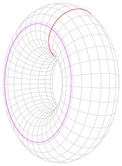जड़त्वाघूर्णों की सूची
नेविगेशन पर जाएँ
खोज पर जाएँ
यहाँ पर विभिन्न आकार-प्रकार के पिण्डों के जड़त्वाघूर्ण दिये गये हैं। ज। दत्वाघूर्ण की इकाई की विमा द्रव्यमान × लम्बाई2 होती है। नीचे दिये गये व्यंजकों की गणना में यह माना गया है कि घनत्व सर्वत्र समान है।
टिप्पणी: जहाँ कहीं भी अलग से न कहा गया हो, यह माना गया है कि घूर्णन-अक्ष द्रव्यमान केन्द्र से जाता है।
| वर्णन | चित्र | जड़त्वाघूर्ण | टिप्पणी |
|---|---|---|---|
| पतला बेलनाकार शेल (shell) जिसके सिरे खुले हैं, त्रिज्या r तथा द्रव्यमान m |  |
<math>I = m r^2 \,\!</math> | शेल की मोटाई को नगण्य (शून्य) माना गया है। यह अगले पिण्ड का एक विशेष दशा है जिसमें r1=r2. |
| मोटी दिवार वाली खुले सिरों वाली बेलनाकार नली जिसकी अन्त:त्रिज्या r1, वाह्य त्रिज्या r2, लम्बाई h एवं द्रव्यमान m | 
|
<math>I_z = \frac{1}{2} m\left({r_1}^2 + {r_2}^2\right)</math>[१] <math>I_x = I_y = \frac{1}{12} m\left[3\left({r_2}^2 + {r_1}^2\right)+h^2\right]</math> or when defining the normalized thickness tn = t/r and letting r = r2, then <math>I_z = mr^2\left(1-t_n+\frac{1}{2}t_n^2\right) </math> |
घनत्व ρ और उपरोक्त ज्यामिति के साथ <math>I_z = \frac{1}{2} \pi\rho h\left({r_2}^4 - {r_1}^4\right)</math> |
| r त्रिज्या, h उंचाई, तथा m द्रव्यमान का ठोस बेलन |  |
<math>I_z = \frac{m r^2}{2}\,\!</math> <math>I_x = I_y = \frac{1}{12} m\left(3r^2+h^2\right)</math> |
This is a special case of the previous object for r1=0. |
| Thin, solid disk of radius r and mass m |  |
<math>I_z = \frac{m r^2}{2}\,\!</math> <math>I_x = I_y = \frac{m r^2}{4}\,\!</math> |
This is a special case of the previous object for h=0. |
| Thin circular hoop of radius r and mass m |  |
<math>I_z = m r^2\!</math> <math>I_x = I_y = \frac{m r^2}{2}\,\!</math> |
This is a special case of a torus for b=0. (See below.) |
| Solid sphere of radius r and mass m |  |
<math>I = \frac{2 m r^2}{5}\,\!</math> | A sphere can be taken to be made up of a stack of infinitesimal thin, solid discs, where the radius differs from 0 to r. |
| Hollow sphere of radius r and mass m |  |
<math>I = \frac{2 m r^2}{3}\,\!</math> | Similar to the solid sphere, only this time considering a stack of infinitesimal thin, circular hoops. |
| Oblate Spheroid of major a, minor b and mass m | <math>I = \frac{2 m b^2}{3}\,\!</math> | — | |
| Right circular cone with radius r, height h and mass m |  |
<math>I_z = \frac{3}{10}mr^2 \,\!</math> <math>I_x = I_y = \frac{3}{5}m\left(\frac{r^2}{4}+h^2\right) \,\!</math> |
— |
| Solid cuboid of height h, width w, and depth d, and mass m |  |
<math>I_h = \frac{1}{12} m\left(w^2+d^2\right)</math> <math>I_w = \frac{1}{12} m\left(h^2+d^2\right)</math> <math>I_d = \frac{1}{12} m\left(h^2+w^2\right)</math> |
For a similarly oriented cube with sides of length <math>s</math>, <math>I_{CM} = \frac{m s^2}{6}\,\!</math>. |
| Thin rectangular plane of height h and of width w and mass m |  |
<math>
I_c = \frac {m(h^2 + w^2)}{12}\,\!</math>||— | |
| Thin rectangular plane of height h and of width w and mass m (Axis of rotation at the end of the plate) |
 |
<math>I_e = \frac {m h^2}{3}+\frac {m w^2}{12}\,\!</math> | — |
| Rod of length L and mass m |  |
<math>I_{\mathrm{center}} = \frac{m L^2}{12} \,\!</math> | This expression assumes that the rod is an infinitely thin (but rigid) wire. This is a special case of the previous object for w=L and h=d=0. |
| Rod of length L and mass m (Axis of rotation at the end of the rod) |
 |
<math>I_{\mathrm{end}} = \frac{m L^2}{3} \,\!</math> | This expression assumes that the rod is an infinitely thin (but rigid) wire. |
| Torus of tube radius a, cross-sectional radius b and mass m. |  |
About a diameter: <math>\frac{1}{8}\left(4a^2 + 5b^2\right)m</math> About the vertical axis: <math>\left(a^2 + \frac{3}{4}b^2\right)m</math> |
— |
| Plane polygon with vertices <math>\vec{P}_{1}</math>, <math>\vec{P}_{2}</math>, <math>\vec{P}_{3}</math>, ..., <math>\vec{P}_{N}</math> and mass <math>m</math> uniformly distributed on its interior, rotating about an axis perpendicular to the plane and passing through the origin. |  |
\vec{P}_{n+1}\times\vec{P}_{n}\|(\vec{P}^{2}_{n+1}+\vec{P}_{n+1}\cdot\vec{P}_{n}+\vec{P}_{n}^{2})}{\sum\limits_{n=1}^{N}\|\vec{P}_{n+1}\times\vec{P}_{n}\|}</math> | — |
इन्हें भी देखें
- समान्तर अक्ष का प्रमेय (Parallel axis theorem)
- क्षेत्राघूर्णों की सूची (List of area moments of inertia)
- जड़त्वाघूर्ण टेंसरों की सूची (List of moment of inertia tensors)
सन्दर्भ
- ↑ Classical Mechanics - Moment of inertia of a uniform hollow cylinder स्क्रिप्ट त्रुटि: "webarchive" ऐसा कोई मॉड्यूल नहीं है।. LivePhysics.com. Retrieved on 2008-01-31.